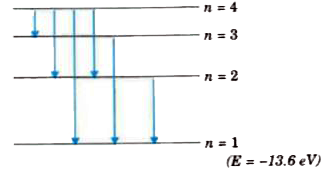Calculate the wavelength for the emission transition if it starts from the orbit having radius ends at . Name the series to which this transition belongs and the region of the spectrum.
Radius of nth orbit of H-like particles
or or
If . Thus the transition is from orbit to orbit. It belongs to Balmer series.
or
It lies in the visible region.
Topper's Solved these Questions
- BOOK - CENGAGE CHEMISTRYCHAPTER - NCERT BASED EXERCISEEXERCISE - Thermodynamics50videos
NCERT BASED EXERCISE
- BOOK - CENGAGE CHEMISTRYCHAPTER - NCERT BASED EXERCISEEXERCISE - Chemical Equilibrium72videos
NCERT BASED EXERCISE
- BOOK - CENGAGE CHEMISTRYCHAPTER - NCERT BASED EXERCISEEXERCISE - Redox Reaction25videos
NCERT BASED EXERCISE
- BOOK - CENGAGE CHEMISTRYCHAPTER - ISOMERISMEXERCISE - Assertion-Reasoning Type1videos
ISOMERISM
- BOOK - CENGAGE CHEMISTRYCHAPTER - ORGANIC REACTION MECHANISMEXERCISE - Analytical and Descriptive6videos
ORGANIC REACTION MECHANISM
Similar Questions
Calculate the wavelength for the emission transition if it starts from the orbit having radius 1.3225nm ends at 211.6pm. Name the series to which this transition belongs and the region of the spectrum.
View Solution(a) In hydrogen atom an electron undergoes transitions from 2nd excited state to the 1st excited state and then to the ground state. Identify the spectral series to which transition belong .
(b) Find out the ratio of the wavelenght of the emitted radiations in the two cases.View Solution
Knowledge Check
- Question 1 - Select One
By calculating the wavelength for the emission transition, if it starts from the orbit having radius 1.3225 nm and ends at 211.6 pm, name the series to which this transition belongs and the region of the spectrum.
ABalmer series, visible region.BLyman series, UV-regionCPaschen series, IR-region.DBrackett series, IR-region. - Question 2 - Select One
What would be the wavelength and name of series respectively for the emission transition for H-atom if it starts from the orbit having radius 1.3225 nm and ends at 211.6 pm?
A434 nm, BalmerB434 pm, PaschenC545 pm, PfundD600 nm, Lyman
Emission transitions in the Paschen series end at orbit n=3 and start from orbit n and can be represented as v=3.29×1015(Hz)[1/32−1/n2] . Calculate the value of n if the transition is observed at 1285 nm. Find the region of the spectrum.
View SolutionIn Bohr's theory of hydrogen atom , calculate the energy of the photon emitted during a transition of the electron from the first excited state to its ground state . Write in which region of the electromagnetic spectrum this transition lies . Given Rydbergy constant R=1.03×107m−1 .
View SolutionCalculate the wavelength of the radiations in nanometers emitted when an electron in hydrogen atom jumps from third orbit to the ground state. (RH=109677cm−1)
View SolutionEmission transitions in the Paschen series end at orbit n=3 and start from orbit n and can be represented as v=3.29×1015(Hz)[1/32−1/n2] . Calculate the value of n if the transition is observed at 1285 nm. Find the region of the spectrum.
View SolutionEnergy level diagram of a hydrogen atom is shown below :

(i)If a transition takes place from n=3 to n=2 orbit, calculate the wavelength of the radiation emitted. Identify the spectral series to which it belongs.
(ii)Which transition results in emission of radiation of maximum wavelength ?View SolutionDetermine the wavelength of the first Lymanline,the transition from n=2ton=1.In what region of the electromagnetic spectrum does this line lie ?
View Solution

